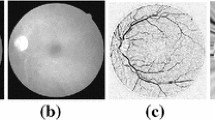Abstract
Appropriate vascular segmentation is dependent on effective picture pre-processing techniques that improve the contrast of the blood vessels, reduce noise, eliminate non-uniform illumination, highlight thin vessels, and retain background texture. These techniques are necessary for accurate vessel segmentation. Here, both the edge- and texture-smoothed data from the vessel probability map are used in the derivation of the adaptive optimal q-order in the G-L mask. The smooth information is not affected, the textures are maintained, and the contrast of the blood vessels is enhanced, thanks to the proposed filter. In addition to sharpening the focus on the vessels themselves, a Gaussian curve fitting is used to contrast stretch the entire image. Retinal fundus images processed with cerebral DSA are subjected to both qualitative and quantitative assessments of contrast enhancement. Quantitative performance indicators are tabulated and compared to other approaches to show how well this technique works for improving medical images everywhere. The suggested filter is easy to implement, flexible enough to adapt to different images, and effective at increasing both vessel contrast and overall image contrast.






Similar content being viewed by others
References
Al-Bander B, Williams BM, Al-Nuaimy W, Al-Taee MA, Pratt H, Zheng Y. Dense fully convolutional segmentation of the optic disc and cup in colour fundus for glaucoma diagnosis. Symmetry. 2018;10(4):87.
Almotiri J, Elleithy K, Elleithy A. Retinal vessels segmentation techniques and algorithms: a survey. Appl Sci. 2018;8(2):155.
Aslani S, Sarnel H. A new supervised retinal vessel segmentation method-based on robust hybrid features. Biomed Signal Process Control. 2016;30:1–12.
Badsha S, Reza AW, Tan KG, Dimyati K. A new blood vessel extraction technique using edge enhancement and object classification. J Digit Imaging. 2013;26(6):1107–15.
Bhargava S, Somkuwar A. Evaluation of noise exclusion of medical images using hybridization of particle swarm optimization and bivariate shrinkage methods. Int J Electr Comput Eng. 2015;5(3):421–8.
Shukla S, Roy V, Prakash A, "Wavelet Based Empirical Approach to Mitigate the Effect of Motion Artifacts from EEG Signal," 2020 IEEE 9th International Conference on Communication Systems and Network Technologies (CSNT), Gwalior, India, 2020, pp. 323–326, doi: https://doi.org/10.1109/CSNT48778.2020.9115761.
Carballal A, Novoa FJ, Fernandez-Lozano C, Garcia-Guimaraes M, Aldama-Lopez G, CalviNo-Santos R, Vazquez-Rodriguez JM, Pazos A. Automatic multiscale vascular image segmentation algorithm for coronary angiography. Biomed Signal Process Control. 2018;46:1–9.
Castro VM, Dligach D, Finan S, Yu S, Can A, Abd-El-Barr M, Gainer V, Shadick NA, Murphy S, Cai T, Savova G, Weiss ST, Du R. Large-scale identification of patients with cerebral aneurysms using natural language processing. Neurology. 2017;88(2):164–8.
Cervantes-Sanchez F, Cruz-Aceves I, Hernandez-Aguirre A, Hernandez-Gonzalez MA, Solorio-Meza SE. Automatic segmentation of coronary arteries in X-ray angiograms using multiscale analysis and artificial neural networks. Appl Sci. 2019;9(24):5507.
Chalakkal RJ., Abdulla WH, Hong SC (2020), Fundus retinal image analyses for screening and diagnosing diabetic retinopathy, macular edema, and glaucoma disorders, in ‘Diabetes and Fundus OCT’, pp. 59–111.
Chen Q, Huang G, Men T, Qin H, Wang M. Fractional differential algorithm for texture and contrast enhancement. Eighth Int Conf Digit Image Process. 2016;10033:1003323.
Chen S, Zhao F. The adaptive fractional order differential model for image enhancement based on segmentation. Int J Pattern Recognit Artif Intell. 2018;32(3):1854005.
Chen Y. (2017), ‘A labeling-free approach to supervising deep neural networks for retinal blood vessel segmentation’, arXiv preprint arXiv: 1704.07502.
Albargathe SMBK, Kamberli E, Kandemirli F, Rahebi J. Blood vessel segmentation and extraction using H-minima method based on image processing techniques. Multimed Tools Appl. 2021;80(2):2565–82.
Li A, Zaki WMDW, Hussain A. Retinal blood vessel segmentation from retinal image using b-cosfire and adaptive thresholding Indonesian. J Electr Eng Comput Sci. 2019;13:1199–207. https://doi.org/10.11591/ijeecs.v13.i3.pp1199-1207.
Almotiri J, Elleithy K, Elleithy A. A multi-anatomical retinal structure segmentation system for automatic eye screening using morphological adaptive fuzzy thresholding. IEEE J Transl Eng Health Med. 2018;6:1–23.
An C, Wang Y, Zhang J, Bartsch D-UG, Freeman WR. Fovea localization neural network for multimodal retinal imaging. Appl Mach Learn. 2020;11511:196–202.
. Shukla S, Roy V, Prakash A, "Wavelet Based Empirical Approach to Mitigate the Effect of Motion Artifacts from EEG Signal," 2020 IEEE 9th International Conference on Communication Systems and Network Technologies (CSNT), 2020, pp. 323–326, doi: https://doi.org/10.1109/CSNT48778.2020.9115761.
Nasr EE, et al. Segmentation of vessels in angiograms using convolutional neural networks. Biomed Signal Process Control. 2018;40:240–51.
Aziah A, et al. “Retinal blood vessel segmentation from retinal image using B-COSFIRE and adaptive thresholding. Indones J Elect Eng Comput Sci (IJEECS). 2019;13:1199–207.
Long J, Shelhamer E, Darrell T. Fully Convolutional Networks for Semantic Segmentation. In Proceedings of the IEEE Conference on Computer Vision and Pattern Recognition (CVPR), Boston, MA, USA, 7–12 June 2015; pp. 3431–3440.
Shi F, Yang J. Multiscale vesselness based bilateral filter for blood vessel enhancement. Electron Lett. 2009;45(23):1152–4.
Author information
Authors and Affiliations
Corresponding author
Ethics declarations
Conflict of Interest
The authors declare that there is no conflict of interests regarding the publication of this paper.
Ethical Approval
This article does not contain any studies with human participants or animals performed by any of the authors.
Additional information
Publisher's Note
Springer Nature remains neutral with regard to jurisdictional claims in published maps and institutional affiliations.
This article is part of the topical collection “Research Trends in Computational Intelligence” guest edited by Anshul Verma, Pradeepika Verma, Vivek Kumar Singh, and S. Karthikeyan.
Rights and permissions
Springer Nature or its licensor (e.g. a society or other partner) holds exclusive rights to this article under a publishing agreement with the author(s) or other rightsholder(s); author self-archiving of the accepted manuscript version of this article is solely governed by the terms of such publishing agreement and applicable law.
About this article
Cite this article
Warrier, G.S., Mahapatra, H., Khuntia, M. et al. An Improved Combined Adaptive Outline for Contrast Enhancement of Blood Vessels. SN COMPUT. SCI. 4, 676 (2023). https://doi.org/10.1007/s42979-023-02069-5
Received:
Accepted:
Published:
DOI: https://doi.org/10.1007/s42979-023-02069-5




